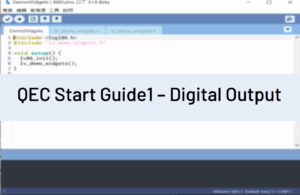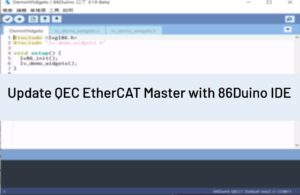[Data Types]
描述
On the 86Duino, unsigned ints (unsigned integers) are the same as ints in that they store a 4 byte (32-bit) value. Instead of storing negative numbers however they only store positive values, yielding a useful range of 0 to 4,294,967,295 (2^32 – 1).
The difference between unsigned ints and (signed) ints, lies in the way the highest bit, sometimes refered to as the “sign” bit, is interpreted. In the 86Duino int type (which is signed), if the high bit is a “1”, the number is interpreted as a negative number, and the other 31 bits are interpreted with 2’s complement math.
Example Code
unsigned int ledPin = 13;
語法
unsigned int var = val;
var – your unsigned int variable nameval – the value you assign to that variable
Coding Tip
When variables are made to exceed their maximum capacity they “roll over” back to their minimum capacitiy, note that this happens in both directions
unsigned int x x = 0; x = x - 1; // x now contains 4,294,967,295 - rolls over in neg direction x = x + 1; // x now contains 0 - rolls over
Math with unsigned variables may produce unexpected results, even if your unsigned variable never rolls over.
The MCU applies the following rules:
The calculation is done in the scope of the destination variable. E.g. if the destination variable is signed, it will do signed math, even if both input variables are unsigned.
However with a calculation which requires an intermediate result, the scope of the intermediate result is unspecified by the code. In this case, the MCU will do unsigned math for the intermediate result, because both inputs are unsigned!
unsigned int x = 5; unsigned int y = 10; int result; result = x - y; // 5 - 10 = -5, as expected result = (x - y) / 2; // 5 - 10 in unsigned math is 65530! 65530/2 = 32765 // solution: use signed variables, or do the calculation step by step. result = x - y; // 5 - 10 = -5, as expected result = result / 2; // -5/2 = -2 (only integer math, decimal places are dropped)
Why use unsigned variables at all?
- The rollover behaviour is desired, e.g. counters
- The signed variable is a bit too small, but you want to avoid the memory and speed loss of long/float.
參考
- [程式語法] byte
- [程式語法] int
- [程式語法] long
- [程式語法] unsigned long
- [程式語法] Variable Declaration
語法參考主頁面
86Duino 參考的文本是根據 Creative Commons Attribution-ShareAlike 3.0 License,部分文本是從 the Arduino reference 修改的。 參考中的代碼示例已發佈到公共領域。



